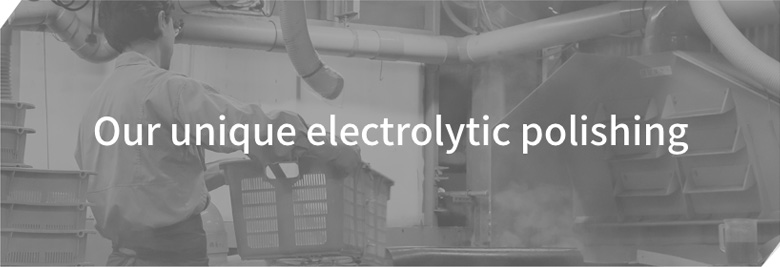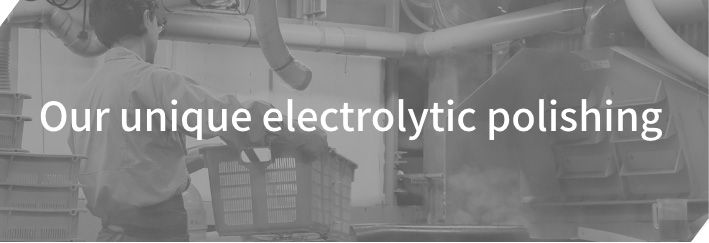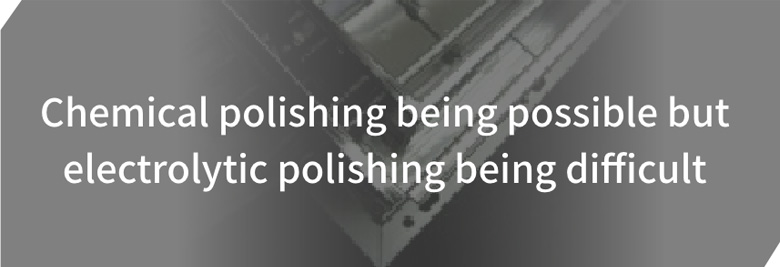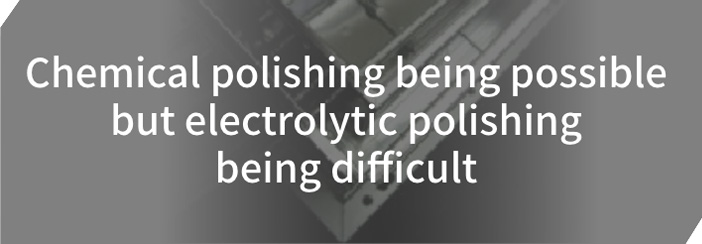- TOP
- Handy guide of stainless
- Salient feature of polishing
Respective salient features of
electrolytic polishing, chemical polishing
and buff polishing
Electrolytic polishing
When the direct current is turned on to the subject metal as plus, during dipped in the respective electrolytic polishing solvent, the metal surface brings about the phenomenon of smoothness and brilliance of the metal surface, together with the proceeding of metal melting.
Electrolytic polishing is the method that has capitalized on the phenomenon, the method has been employed to especially austenite type stainless (SUS304 and SUS316, etc.) and aluminum.
While mechanical grinding (grinder, sandpaper, buff) removes the unevenness of the surface through cutting, transformation and abrasion by the force of whetstone with pressure, on the other hand electrolytic polishing method gains smoothness and brilliance achieved by the effect of preferential melting of surface convex portions which has been deemed to be very clean polishing method, without forming process degenerated layer, nor leaving any burning marks nor stains caused by residues on its surface.
Chemical polishing
Chemical polishing is a method to melt the surface of the subject metal by the chemical response dipped in the special solvent.
Chemical polishing as well as electrolytic polishing carries out polishing to stainless formed product, however, chemical polishing has been more suitable to be employed to such cases as to remove foreign substances, residual scales from the stainless surface that has complicated shapes and their washing.
Buff polishing
Buff polishing is the way to polish the subject substance by those clothes cut into circle and saw them to have certain thickness or bias shaped clothes piled up into some thickness coated with polishing agent around their outer ends.
This process method has the feature to polish only surface of the formed items, different from polishing by grinder machine.
The major process of the polishing starts with rough polishing and proceed up to final finishing polishing to have brilliance on its surface, taking several times actions.

| Effect and advantage | Problem | |
|---|---|---|
| Electrolytic polishing |
This polishing method achieves the smoothness and brilliance by the preferential melting effect to remove the minute convex portion on the surface, Since it produces clean polished surface and create stronger passivate film, so that the corrosion resistance improves considerably. |
As compared with such mechanical polishing as buff polishing, this electrolytic polishing is less recommendable to be applied to the products having big unevenness, or roughness or to remove large burrs from surface. Also, this method may suffer from bringing about white cloud or less uniformity, when the electric currency runs unstable. In order to achieve the desired smoothness and brilliance, you are recommended to firstly have the pre-smooth surface by buff polishing in advance and give the electrolytic polishing to have the desired final finish. |
| Chemical polishing |
By the merit of melting the surface, it creates cleanliness, and smoothness and brilliance by the effect of removing minute unevenness. Polishing has been done by the melting power of treatment solvent without electric currency run,it is most likely to cause less uniformity and is easily complying with complicated shapes of the products. |
Solvent management (e.g. solvent replacement and waste solvent liquid) becomes necessary, because there occurs irregularity in the solvent pattern to be caused by the changes of treatment solvent which happens along with the proceeding of the treatment in which iron and nickel chrome dissolves that smoothness and brilliance are created by the melting power of treatment solvent. |
| Buff polishing |
This method can make rough or uneven surface to brilliant, even surface and can remove large burr brought about from the cutting of press processing. |
Since this method cannot remove all whetstone grains, buff debris, oil or compound from the surface, those whetstone grains or metal debris embedded in the surface that are hard to be removed them all by this method, become the cause of the corrosion. Also, the processed finish by this method would not be acceptable to the places where cleanness is strictly demanded, because minute unevenness and grinding streaks remained on the surface are likely to becomes the cause to stick the contaminant. |
As for the most desirable process to achieve the smooth and clean surface are as follows,
- ■Remove conspicuous unevenness and undulation with buff polishing
- ↓
- ■Electrolytic polishing and chemical polishing will do the followings,
- ○Remove the fine unevenness,
- ○Recover the property of stainless reduced by preliminary processing,
- ○Remove the impurities (cleaning),
- ○Corrosion resistance improvement.
Is regarded as most desirable.









